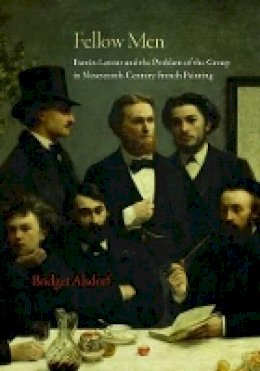
Stock image for illustration purposes only - book cover, edition or condition may vary.
Fellow Men: Fantin-Latour and the Problem of the Group in Nineteenth-Century French Painting
Bridget Alsdorf
€ 97.42
FREE Delivery in Ireland
Description for Fellow Men: Fantin-Latour and the Problem of the Group in Nineteenth-Century French Painting
Hardback. Focusing on the art of Henri Fantin-Latour (1836-1904) and his colleagues Gustave Courbet, Edgar Degas, Edouard Manet, Frederic Bazille, and Pierre-Auguste Renoir, this book argues for the importance of the group as a defining subject of nineteenth-century French painting. Num Pages: 352 pages, 42 color illus. 122 halftones. BIC Classification: 1DDF; 3JH; ACV; AFC. Category: (P) Professional & Vocational. Dimension: 189 x 260 x 27. Weight in Grams: 1234.
Focusing on the art of Henri Fantin-Latour (1836-1904) and his colleagues Gustave Courbet, Edgar Degas, Edouard Manet, Frederic Bazille, and Pierre-Auguste Renoir, Fellow Men argues for the importance of the group as a defining subject of nineteenth-century French painting. Through close readings of some of the most ambitious paintings of the realist and impressionist generation, Bridget Alsdorf offers new insights into how French painters understood the shifting boundaries of their social world, and reveals the fragile masculine bonds that made up the avant-garde. A dedicated realist who veered between extremes of sociability and hermetic isolation, Fantin-Latour painted group dynamics over the course of two decades, from 1864 to 1885. This was a period of dramatic change in French history and art--events like the Paris Commune and the rise and fall of impressionism raised serious doubts about the power of collectivism in art and life. Fantin-Latour's monumental group portraits, and related works by his friends and colleagues from the 1850s through the 1880s, represent varied visions of collective identity and test the limits of association as both a social and an artistic pursuit. By examining the bonds and frictions that animated their social circles, Fantin-Latour and his cohorts developed a new pictorial language for the modern group: one of fragmentation, exclusion, and willful withdrawal into interior space that nonetheless presented individuality as radically relational.
Product Details
Format
Hardback
Publication date
2013
Publisher
Princeton University Press
Number of pages
392
Condition
New
Number of Pages
352
Place of Publication
New Jersey, United States
ISBN
9780691153674
SKU
V9780691153674
Shipping Time
Usually ships in 7 to 11 working days
Ref
99-1
About Bridget Alsdorf
Bridget Alsdorf is an assistant professor in the Department of Art and Archaeology at Princeton University.
Reviews for Fellow Men: Fantin-Latour and the Problem of the Group in Nineteenth-Century French Painting
"[S]cholarly, exact, and closely argued."
Julian Barnes, London Review of Books "[Fellow Men] is a most meticulous and wide-ranging study."
Choice "Bridget Alsdorf has written a fluent, carefully considered book... Staying admirably close to the paintings and the preparatory drawings for each, Alsdorf exposes many of the contradictions that linger around Fantin-Latour's oeuvre, often signaling these in crisply aphoristic terms."
Anne Leonard, Nineteenth-Century French Studies "It is the great virtue of Alsdorf's study that she is able to penetrate the mysterious solemnity of such a work, and to demonstrate how Fantin's group portraits, for all their apparent dignity and restraint, are riven by conflicts that help to sharpen an understanding of artistic identity and bourgeois masculinity in the formative decades of cultural modernity."
Neil F. McWilliam, caa.reviews "[The book is] an invaluable addition to the literature not only on Fantin-Latour but on the subject of group portraiture. Perhaps the most effective service it performs for Fantin's group portraits is to force us to look at them anew and see them in all their complexity, awkwardness and discomfort, to tease out the many contradictions at their heart."
Rachel Sloan, Burlington Magazine
Julian Barnes, London Review of Books "[Fellow Men] is a most meticulous and wide-ranging study."
Choice "Bridget Alsdorf has written a fluent, carefully considered book... Staying admirably close to the paintings and the preparatory drawings for each, Alsdorf exposes many of the contradictions that linger around Fantin-Latour's oeuvre, often signaling these in crisply aphoristic terms."
Anne Leonard, Nineteenth-Century French Studies "It is the great virtue of Alsdorf's study that she is able to penetrate the mysterious solemnity of such a work, and to demonstrate how Fantin's group portraits, for all their apparent dignity and restraint, are riven by conflicts that help to sharpen an understanding of artistic identity and bourgeois masculinity in the formative decades of cultural modernity."
Neil F. McWilliam, caa.reviews "[The book is] an invaluable addition to the literature not only on Fantin-Latour but on the subject of group portraiture. Perhaps the most effective service it performs for Fantin's group portraits is to force us to look at them anew and see them in all their complexity, awkwardness and discomfort, to tease out the many contradictions at their heart."
Rachel Sloan, Burlington Magazine
